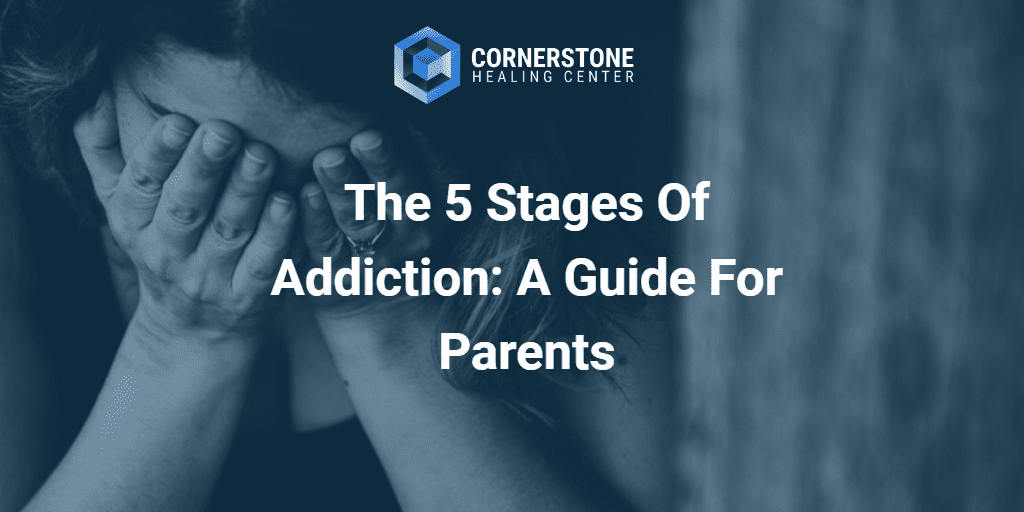What are the five stages of addiction? If you’re a parent asking this question because you’re trying to gauge where your son or daughter is in their addiction, here’s what you need to know.
We cover the five stages of addiction and what you need to know.
So, your son or daughter might be using drugs
Nothing compares to your panic when you learn your son or daughter is using drugs. You might be angry, disappointed, or hurt. Perhaps you’re embarrassed, or you blame yourself. Maybe you don’t know what to think.
Maybe it’s all of the above.
According to the Substance Abuse and Mental Health Services Administration, 21 million1 U.S citizens required treatment for their addictions in 2016.
This makes up 7.6% of the population and includes kids as young as 12.
The concerning statistic calls for action on the part of the parents to recognize the signs and stages of addiction so they can protect their children.
The road to addiction often begins with a simple desire to experiment or try a substance just for fun.
Unfortunately, this one-time experimentation leads to regular use, use of hard drugs, dependency, and eventually addiction.
The best thing a parent can do in this situation is to arm themselves with the facts.
Before you act on any of the above emotions, learn the five stages of drug addiction. Knowing where your child is, you can find out the best way to help them.
Nuggets: A touching animated illustration of addiction.
Stage 1: Experimentation
Experimentation is often the gateway to drug use for many people. Here’s all you need to know about this stage of drug use.
What Is An Experimental User Of Drugs?
Our modern lifestyle often results in overburdening ourselves, lack of self-care, and physical strain, and can also cause mental health issues.
To escape from the ‘normal, stressful routine’ of life, people tend to rely on drugs to provide them with the calming, relaxing effect they are looking for.
In other cases, users have experienced some trauma- sexual, physical, or second-hand violence- that prevents them from functioning normally.
In an attempt to forget the traumatic event and put an end to the constant reminders of it, they succumb to drugs as an escape.
These instances or situations lead to individuals experimenting with drugs. These experimental users of drugs are looking to find relief, calm, serenity, and an escape from the tragedies of life.
Unfortunately, while their aim might be innocent, their chosen form of achieving that goal is deadly.
The supposed benefits prescribed medication provides are nearly unrelated to the threat they pose in causing addiction.
Also, it’s known that pairing these drugs with alcohol, tobacco, or illegal drugs can increase the chances of reliance.
Suppose an individual or child is not adequately educated or guided regarding using an addictive medication.
In that case, they might end up getting themselves addicted through risky behavior- taking more than prescribed or mixing them with alcohol/substances- without actually intending to do so.
Is It Good To Experiment With Drugs?
Not. It is never a good idea to experiment with drugs in any way, especially today. Look, it’s not the 2000s or 2010s anymore where drugs used to be what they were advertised (mostly).
Drugs are now laced with fentanyl, which is highly deadly. Sadly, teens and young adults experimenting now may suffer an overdose.
We often hear individuals saying,
“One time won’t hurt.”
The common phrase might give them an excuse to do what they desire, but it holds no truth.
In the stages of addiction, experimentation is the first stage because this is where the issue begins.
But unfortunately, even that one hit, smoke, or sip can lead to consistent use, which can further lead to dependency or addiction.
There is no healthy or correct way of experimenting with drugs. Lowering the dosage of the substance or drug abuse will not prevent your body’s craving for it or your desire for the calming, relaxing effect again.
In many cases, parents also believe that if they allow their children to experiment under their supervision with tobacco, alcohol, or drugs, they will be able to take the thrill out of the act and prevent their children from doing so behind their backs.
While this technique may work well with a few, most kids return for more just because of how they feel when under the influence.
This is especially harmful to teenagers since many of them are in their rebellious phase or are dealing with peer pressure; this might lead to repeated behavior or steer them towards hard drugs despite the ‘thrill’ of being out of the act.
Why Do Adolescents Or Adults Experiment With Drugs?
The Substance Abuse and Mental Health Services Administration stated that almost 20% of Americans had tried some drug.
The reasons behind experimenting are;
Fitting In With The Crowd:
As a teenager or adult, you might end up running with the wrong crowd, or perhaps your old friends are falling into the trap of drugs. Feeling left out of plans might urge you to try substances so that you could feel like a friend again.
Peer Pressure:
Similarly, you might want to feel accepted and become friends with the popular crowd. Attending parties or hanging out with a particular group can push you into drug experimentation.
To Boost Your Mood:
As a way of boosting your mood, relaxing, or feeling good, individuals might use drugs to achieve the desired effect.
Rebellion:
Many teenagers use drugs as a form of rebellion. Even if their parents are unaware of their actions, they will continue to do so because they like the feeling of making independent decisions or doing something behind their parents’ backs.
To Improve Themselves:
Recreational drugs can boost an individual’s cognitive and physical abilities. In a competitive society, teenagers or adults might feel compelled to use drugs to win the race.
Stage 2: Regular Use
Regular use is when your son or daughter’s drug use becomes more and more woven into their every day. Here’s what to know about the regular use stage.
What Does Regular Drug Use Look Like?
By this point, your child might have settled on a specific drug they want to use consistently.
But, on the other hand, your child might have developed a habit of using the medicine routine. This might be social- consumed with friends or at parties- or they might also be consuming alone if their purpose is to relax.
The most significant indicator of regular drug use is a change in their daily routines. Your child will take time during their daily routine to use drugs.
You might notice that they spend more time outside the house or with a specific friend.
On the other hand, they might also choose to spend more time alone or away from you, in general.
Moreover, there might be a change in their eating and sleeping routines as well. For example, if your son or daughter takes hard drugs such as cocaine or methamphetamine, they might sleep less than before.
In addition, other drugs like fentanyl, heroin, and benzos (like Xanax) cause excessive sleepiness or multiple naps throughout the day.
Your son or daughter can also experience an increase or decrease in appetite, depending on the drug being used.
While these warning signs are pretty easy to dismiss since many teenagers now have a habit of sleeping late or eating less, it is still essential to keep an eye out for such behaviors since they can help you prevent an addiction during the early stages.
What Are Some Signs To Look For During This Time?
You should pay more attention to your child’s changing behavior if:
- They are isolating themselves from you. They might be choosing to spend more time in their room or outside the house- socializing more than they did before.
- You notice a change in their academic grades, or they are careless about work. Even if their grades are consistent, you will see how they study less or are not prioritizing their education anymore. To sway suspicion, your child might use cheat sheets to pass classes.
- They are defensive about their behavior or choose to hide their activities from you. This might include aggressiveness when you go to their room or refusal to talk about their changed behavior.
- You might also notice a lack of hygiene. Your child might be repeating clothes too many times, wearing the same hoodie or t-shirt that hides their body, or even being lazy about taking showers.
- They ask for more money than usual., Sometimes, you might also notice missing cash from your purse/wallet. You might even be missing items from around your home.
- They are becoming more irritable or annoyed. They lack patience, especially with their parents or siblings.
- They seem incredibly unmotivated to do anything at all. Even simple chores or leaving the house has become a massive task for them to fulfill.
Stage 3: Risky Drug Use
What Is Risky Drug Use?
Risky drug use is often referred to as teenagers indulging in risky behavior when under the influence of drugs.
Many teens no longer care about their safety or the safety of others and continue their dangerous behavior for a thrill.
This is not only limited to taking high dosages but also driving when under the influence, indulging in sexual activities without safety, becoming violent with others, or committing crimes such as stealing or property damage.
It can be common to start experimenting with multiple drugs at once. For example, one typical mix of drugs is ecstasy with alcohol or marijuana joint laced with cocaine.
This type of behavior can lead to an overdose or death, and in best-case scenarios, they might end up living their life with physical disabilities caused by brain damage.
What Are Signs Of Risky Drug Use?
If your child is under the grip of substance abuse, you might notice the following behavior.
- They are facing more trouble at school or work. This can mean that they are either skipping school or work, are not putting in effort even if they go, and are experiencing a decline in their academic performance.
- They may be gaining or losing weight rapidly. You will notice a change in their eating patterns with increased cravings or decreased appetite.
- You will see that they have changes in their eyes when high. Often, this is consistent glassy or red eyes. Depending on the drug, their eyes can be very dilated or pinpointed.
- They are becoming more aggressive, irritated, or angry. They get involved in fights and come home with bruises.
- You will notice their lack of appearance during family get-togethers. They prefer spending time alone, with friends, or outside the house.
- They might be getting in trouble more often. There might be complaints from the school, neighbors, or friends. They might even get in trouble with the local authorities for stealing, property damage, or unkempt behavior.
- Lastly, you will find evidence from their rooms or belongings. Once drug use becomes consistent, the user becomes less worried about how they are hiding their drugs.
Stage 4: Dependence
What Does The Dependence Stage Look Like?
The 4th stage of addiction is where the individual has created a tolerance for the drug and will need considerable amounts of it to feel the effects.
The change in an individual’s behavior is the first indicator of drug dependency. Since the brain is now used to the drug in the body, it will create a craving for it that will lead to higher doses.
By giving in to the desire, the brain’s chemistry will continue to change, resulting in a feeling of “need” rather than “want.”
By creating this dependency, the body will react adversely if the drug is absent. The body will experience withdrawal symptoms that can be easily recognizable by others. Here’s what you should look out for;
- Flu-like symptoms include shivering, coldness, running nose, or a high fever.
- Feelings of depression or insomnia.
- Complaints of muscle weakness or body aches.
- Refusing to eat because of nausea or a persistent upset stomach (diarrhea/constipation).
- Nightmares, anxiety, or panic attacks.
- Body tremors, shakiness, or edginess.
- There might be some hallucinations, paranoia, or seizures in severe cases.
These symptoms are also in line with the symptoms of mental illnesses. Hence, it is essential to differentiate the two by conversing with your child before accusing them of drug abuse.
What Is The Difference Between Addiction And Dependence?
Dependency is nearly as dangerous as addiction. However, there is a thin line between the two where dependence quickly becomes an addiction.
The two can differ as follows;
Dependency: This results from the use of medication for chronic illnesses such as chronic pain, mental disorders, or even simple medicines used to regulate blood pressure or blood sugar levels.
Dependency is often noted as the drug’s physical effects on the body, such as high tolerance, adaptability, addiction-like behavior, or withdrawal symptoms. As a result, the individual will indulge in higher doses of the drug and will always be under the influence.
Addiction: It is stated as the complete dependency on drugs. At this point, the user is no longer trying to hide their addiction; they cannot stop themselves from using the substance. They no longer care about the consequences of it or the effects that it will have on their body.
They will also become less social-able and will not keep up with their education, jobs, hygiene, or any aspect of their life that will serve them. They will also experience all the symptoms of dependency.
Stage 5: Addiction
What Does It Mean To Be Addicted?
Drug addiction is often referred to as a mental disorder since the consistent use of drugs has caused a change in the brain chemistry, the brain circuits, and differences in the release of pleasure or happy hormones.
It is similar to any other chronic disease where the organ affected is no longer functioning normally and is causing harmful effects.
Addiction means that the individual can no longer stop without professional help. They now require the drug to keep themselves functioning normally. The drug is no longer want, a craving, but a need.
Individuals suffering from substance abuse disorder are compulsively looking for the next time they can use. As a result, self-control is non-existent. When drugs aren’t able to be consumed they face serious withdrawal symptoms that are incredibly painful.
For some substances, withdrawal symptoms can be deadly if they are not treated by a professional. However, with the right medications, they’ll be able to get through them at least somewhat comfortably and safely.
What Are The Signs Of Addiction?
The signs of addiction are observed through psychological and physical manifestations. They can be easily noticed by any family member or loved ones. Once you’ve picked up on these signs, it is essential to take action. It’s been said that early intervention for addiction is essential, and this is always true.
The most significant symptom is the drastic changes in mood and behavior. Here are the overall signs to look out for.
Psychological Signs
- Using drugs as an escape.
- Isolating from family or keeping secrets from them. Or changing friend groups.
- Loss of interest in hobbies and activities.
- Issues with school or work. Failing classes or taking days off of work without notice.
- Committing crimes such as stealing to obtain drugs.
- Spending a lot of time trying to obtain drugs.
- Constantly trying to quit but are unable to stop yourself.
- Feeling depressed, anxious, angry, or irritated most of the time.
- Experiencing mood swings.
Physical Signs
- Change in eating or sleeping habits.
- Feeling sick or experiencing flu-like symptoms.
- An increase in drug use or dosage.
- Withdrawal symptoms include abdominal pain, shakiness, tremors, or fevers.
What does Addiction do To The Brain?
The effect the individual enjoys from substance abuse is due to the drug’s influence on the brain. After years of research, scientific evidence has proven that addiction disrupts2 three main areas of the brain;
- Basal Ganglia: It is responsible for our emotions and behavior.
- Extended Amygdala: It is responsible for our emotional comprehension and psychotic episodes.
- Prefrontal Cortex: It is responsible for our cognitive controls such as impulse, memory, attention, problem-solving, and reasoning.
These disruptions are found in the onset, development, and continuity of substance abuse disorders and can result in;
- Triggering the brain into wanting or seeking the drugs. It is similar to creating a craving for a drug.
- The brain becomes less sensitive to pleasure, meaning that the brain only considers drugs as a reward for any behavior. A lack of drugs can also result in increased stress in the brain.
- The individual will start experiencing a decline in their cognitive and control systems. They will feel more reactive to emotions, be impulsive, and lose the ability to make sound decisions, and feel as if they have no control over their actions.
How To Get My Son Or Daughter Help For Addiction?
If you notice any of the stages of addiction in your teen or young adult, it is ideal to step in as soon as possible. The earlier your child receives treatment for their addiction; the easier and long-lasting their recovery will be. Early intervention is everything.
The first step to getting help as a parent is to talk to your child. If you suspect such behavior, you should confront it in a non-aggressive manner.
Instead, try to listen to your child and understand their situation. What made them turn to drugs in the first place? Why did they feel the need to continue?
The aim of the conversation should not be to shame or blame but rather to treat your child with kindness and help them understand that the conversation is meant to bring about a positive change.
If your child is resistant to change, try to give them an incentive. Try to keep the motivation in their favor.
For example, rather than saying they will lose privileges such as driving the car, encourage them to get treatment so you can help them buy a car of their own. In most cases, incentives work for teenagers.
Before discussing with your child, it is essential to be prepared with all the necessary supporting material, starting with the rehabilitation center.
An ideal option to choose will be Cornerstone Healing Center. We are a luxury treatment center located in Arizona and provide treatments for various addictions. We also offer programs according to the severity of the patient.





